Traditional ratatouille is a stewed vegetable dish made with zucchini, eggplant, tomatoes, bell peppers, onions, and garlic, with plenty of extra virgin olive oil, fresh herbs, and red wine.
Roasting the tomatoes and eggplant is a traditional cooking technique that I combine with the somewhat less traditional stewing of the remainder of the vegetables. This way you get the best of the traditional, and your meal is ready in an hour.
Most of all, I just love that a ratatouille has always been a vegetarian recipe, rather than an adaptation of something meat-based! It is also an ideal recipe to enjoy nature's fall bounty. A Thanksgiving vegetarian main dish perhaps?
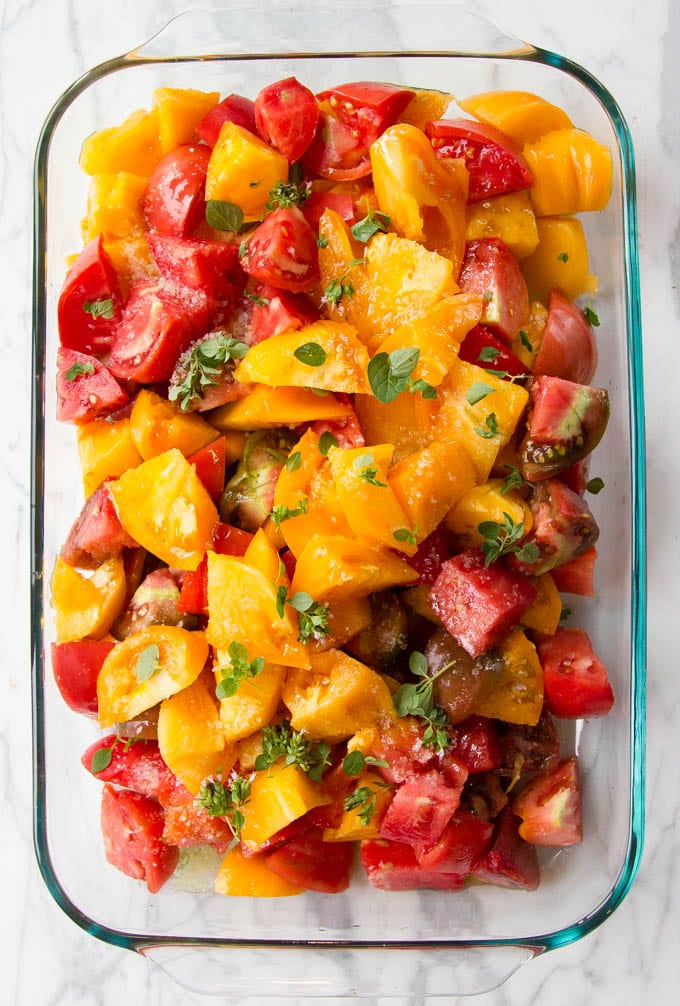
The ingredients for ratatouille flourish alongside the tropical French Mediterranean Sea, where this dish originated.
Remember that there weren’t always grocery stores. People would have kept a basket of vegetables on their counter filled with whatever was harvested.
Anyone who has grown a garden knows that in the late summer and early fall, tomatoes, peppers, and eggplant are all ready at the same time and need to be used up.
Historically, the French must have recognized this perfection in nature’s bounty since they invented such a harmoniously combined dish.
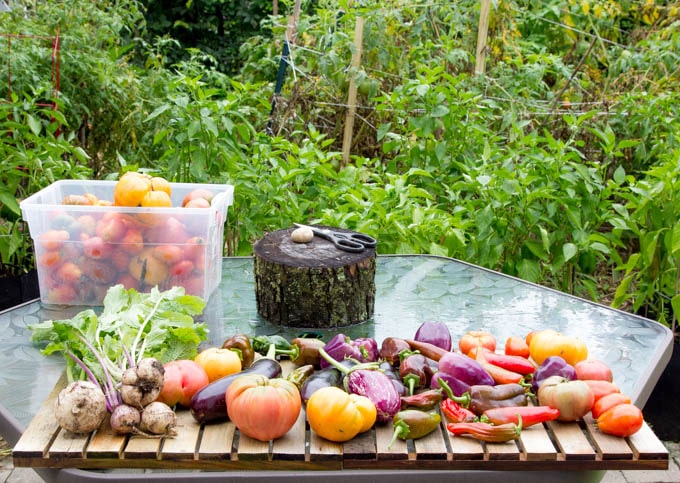
Even if you don’t have locally grown vegetables available where you live, the slow-cooking method for ratatouille is forgiving. It caramelizes and accentuates the natural flavor of any vegetable you use.
So why not give it a try and enjoy a meatless meal tonight?
How Do You Make Ratatouille?
To make this Provencal-style ratatouille recipe, you begin with roasting the tomatoes and eggplant in the oven.
This ensures that you get the maximum flavor benefit of the caramelization, and a deepening of the flavors, without having to work too hard.
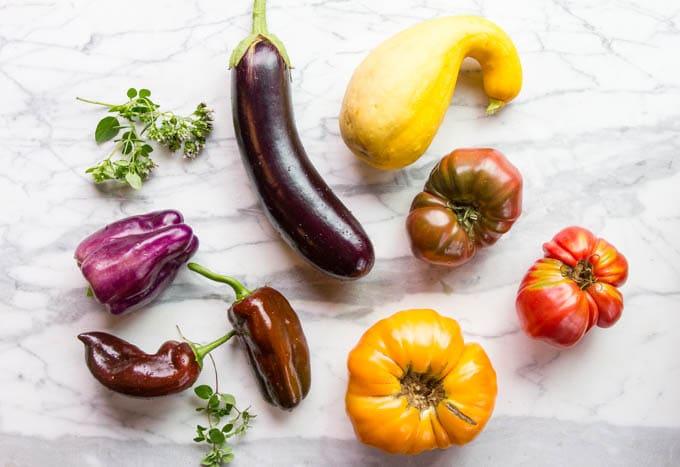
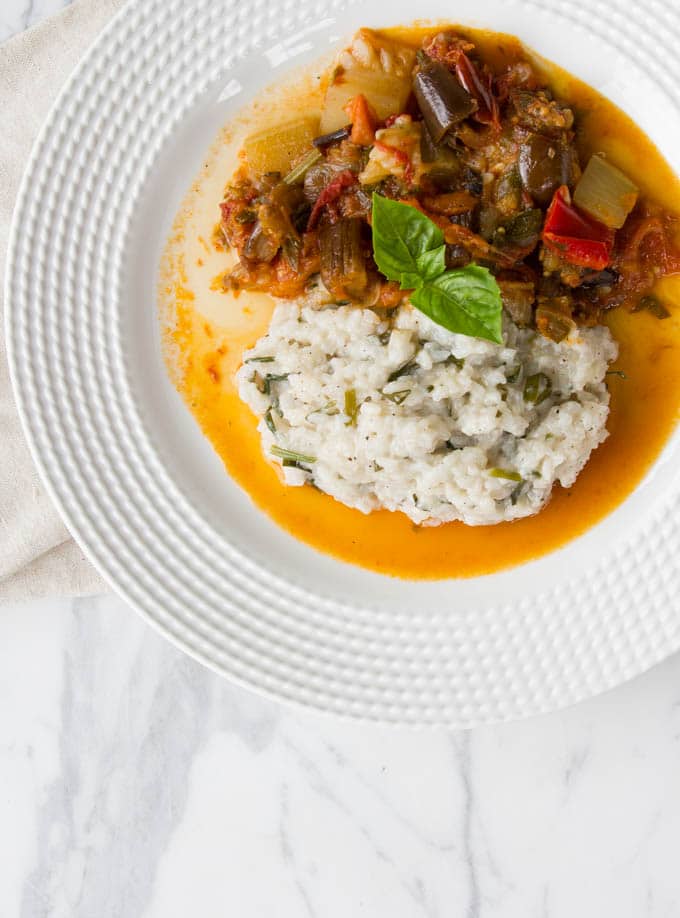
The roasted vegetables are added to a large saucepan of sautéed onion, more garlic, bell peppers, zucchini, and fresh herbs.
Traditionally, red wine is part of a pot of ratatouille. My recipe opts for red wine vinegar instead, but you could certainly use a splash of red wine if you have it, and reduce it down as the vegetables cook.
Traditionally, herbs such as thyme, parsley, and basil part of the dish, but in this recipe I call for oregano, because I enjoy the earthy, hay-like—even minty notes—it adds.
I also happen to have a generous patch of oregano in my garden, which has encouraged me to use it often.
As a side note, oregano is also wonderful in my smoky oregano black beans, and in any Italian dishes. I encourage you to use it more, and let me know if you gain a newfound appreciation for it as I have.
If you are not a fan of oregano, I promise you, a wonderful ratatouille can be made with any of your favorite French or Italian herbs, such as rosemary, basil, thyme, oregano, Herbes de Provence, parsley, or even celery.
If you do choose to use basil though, add it at the very end to preserve its pungent flavor.
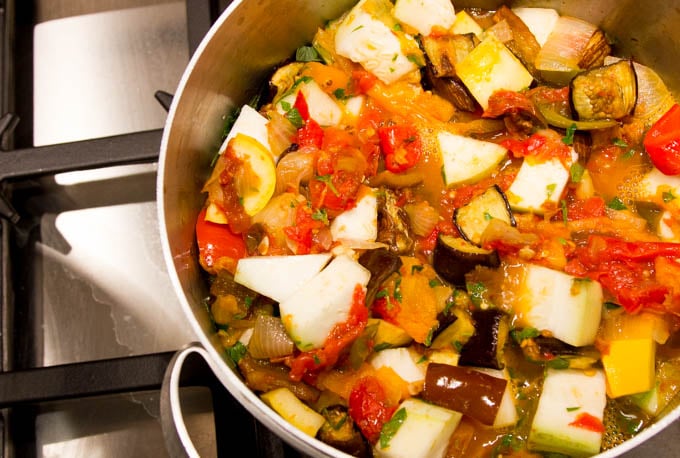
Mostly Traditional Ratatouille, But Much Quicker!
Purists believe that to make ratatouille, each vegetable must be cooked separately. Only then are they combined and cooked slowly together into a stew.
As you can imagine, this is an extremely arduous and time-consuming process.
The New York Times has a recipe like this that involves baking each ingredient separately in the oven until caramelized.
Just imagine! You’d need four baking trays, and two waves of baking in a convection oven, (if you are lucky to have one), and you'd be juggling the trays for a while.
That would already take almost two hours. Next, you’d combine all the ingredients in yet another cooking dish, and continue baking for another hour or so. That is about three hours in a hot oven and good amount of washing the dishes.
The result is surely tasty, but I think that for the work, it isn’t worth being a purist.
This recipe achieves a happy medium between cooking ingredients separately, and cooking them together. It preserves the format of the traditional, while taking into account the time constraints most people face today.
It’s pretty optimal this way, and you can complete this recipe in about an hour.
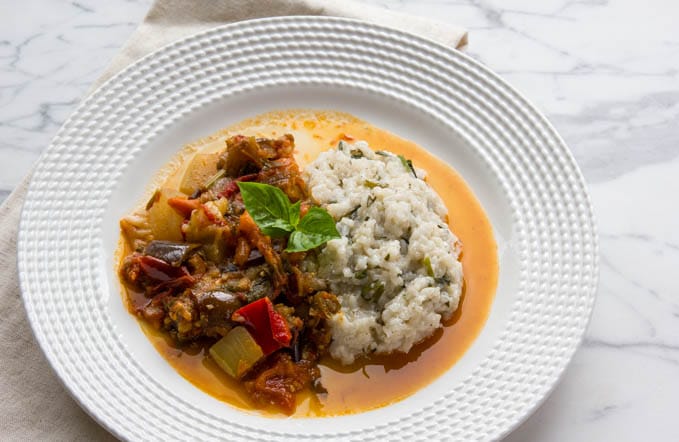
What Do I Serve With Ratatouille?
Ratatouille is made with a cornucopia of vegetables, and yet it does not feel like a complete meal on its own. A quick google search shows that ratatouille is traditionally served as a side with meat.
Since I don’t eat meat, I had this question: what do you serve with ratatouille to turn it into a complete meal?
Below are five suggestions for vegetarian pairings for traditional ratatouille. You got this!
1. With Risotto
A creamy rice dish with parmesan cheese is the perfect pairing with ratatouille. Fortunately, I have just the recipe.
My Easy Vegetarian Risotto With Parmesan And Peas takes only ten minutes to put together. You can prepare the rice, and then use the hot oven to cook it once the ratatouille vegetables are finished baking.
In my original risotto recipe I call for a vegetable topping to maximize the enjoyment of risotto. Traditional ratatouille is the perfect topping for the risotto.
For this pairing, I am going to recommend leaving the peas out, or replacing them with something savory, like finely chopped tomatoes, onion, and/or chives.
Hmmm … enjoy this! I am going to make it tonight!
2. With Pasta
Boil up some pasta to al dente perfection, and mix with ratatouille. Easy and ready!
Add a green salad, and garnish liberally with fresh parmesan cheese to elevate your dining experience.
3. With Poached Eggs And Toast
Poach eggs to medium and place them on top of perfectly browned sourdough toast.
Enjoy the ratatouille on top of the toast and egg, and cut your dinner with a knife and fork. Or, if you prefer, serve the ratatouille on the side.
I can imagine dipping the crusts into the ratatouille and munching it that way too.
4. With Bulgur Wheat
Bulgur wheat is a parboiled wheat berry that is cracked so that it easily absorbs water and cooks quickly.
Bulgur cooks like rice, in about 10–15 minutes, with a ratio of 1 cup wheat to 2 cups water.
The earthy depth of flavor from the whole wheat is a perfect pairing with ratatouille.
In fact, I used to make a salad at a restaurant that featured bulgur wheat with deep-fried eggplant, peppers, onions, and chopped tomatoes in it. That kinda sounds like ratatouille salad doesn’t it? And it was yummy!
5. With Crusty Bread And Fresh Olive Oil
Looking for something more rustic and simple? Get yourself some fresh crusty bread and serve it with the traditional ratatouille, along with quality olive oil and balsamic vinegar for extra dipping.
Add a green salad and garnish everything with fresh parmesan cheese, and your simple dinner is completely amazing.
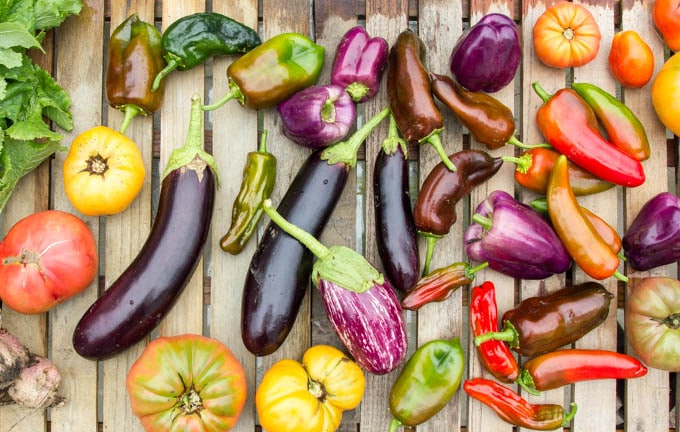

Recipe For (Mostly) Traditional Ratatouille
Ingredients
For baking in the oven
- 1 pound eggplant (1 -2 eggplant), chopped into ¾-inch pieces
- 28 ounces whole peeled tomatoes (a large can) OR 3-4 large fresh tomatoes, skins removed, chopped into 1-inch pieces
- 3 tablespoons extra-virgin olive oil, (portion 1 tablespoon, then 2 tablespoons)
- 6-8 cloves garlic , peeled, smashed, and chopped roughly (portion half, then half)
For the sauté
- 3 tablespoons extra-virgin olive oil
- 1 large yellow onion, chopped into ¾-inch pieces
- 2 bell peppers, any color, seeded and chopped into ¾-inch pieces
- 1 teaspoon Himalayan pink salt, or to taste
- 1 teaspoon freshly ground black pepper, or to taste
- 1 pound large zucchinis (1 -2), chopped into ¾-inch pieces
- 1 bay leaf
- 1 tablespoon fresh oregano leaves, (or ½ tablespoon dried)
- 2 tablespoons red wine vinegar, or to taste
Instructions
- Preheat oven to 350 degrees.
Bake eggplant and tomatoes
- Place chopped eggplant in a colander and toss with 1 ½ teaspoons salt. Let sit 20 minutes, rinse, and then squeeze out excess liquid. Toss with a tablespoon of olive oil, sprinkle with salt and pepper, and bake in the oven for 25 minutes, or until lightly browned.
- For canned whole tomatoes, break them up into 1-inch pieces with a knife, or with your fingers. For fresh tomatoes, blanch them first to remove their skins. Bring water to a boil in a medium saucepan. Slit the tomato skins with a knife and submerge in boiling water for 30 seconds. Use a slotted spoon to remove the tomatoes and shock in a bowl of ice water to cool. Peel off the skins, and chop into 1-inch pieces, preserving the juices as you do so. Pour tomatoes into a baking dish, add half the garlic, and drizzle with two tablespoons olive oil. Bake in the same oven until thickened, about 30 minutes, stirring every 10 minutes.
For the sauté
- While the tomatoes and eggplant bake, start preparing the rest of the vegetables for the saute. Once the onions are chopped, move to the next step to start the sauté.
- Add 3 tablespoons oil to a large (large enough to fit the entire recipe) saucepan over medium heat. Add onion and remaining garlic, stirring occasionally until translucent, about 5 minutes. Meanwhile, chop the bell peppers. Add peppers to the saucepan sauté another 5 minutes. Season with salt and pepper.
- Meanwhile, chop the zucchini. Add zucchini, bay leaf, and oregano, and continue to cook until lightly browned.
- Once the tomatoes and eggplant are out of the oven, add them to the saucepan. Stir well and bring to a boil. Reduce heat to medium-low, cover, and cook at a gentle simmer until vegetables are cooked to your liking. If you prefer the vegetables just tender, it will take about 15 minutes. If you prefer the vegetables well-cooked, it will be more like 30 minutes.
- Add vinegar and stir well. Taste, and adjust salt, pepper, and vinegar to taste. Remove bay leaf before serving.
Notes
Nutrition
Did you make this recipe? Let me know your thoughts in the comments below.
For more Buttered Veg lifestyle content, follow me on Pinterest, Facebook, Instagram, and Twitter.
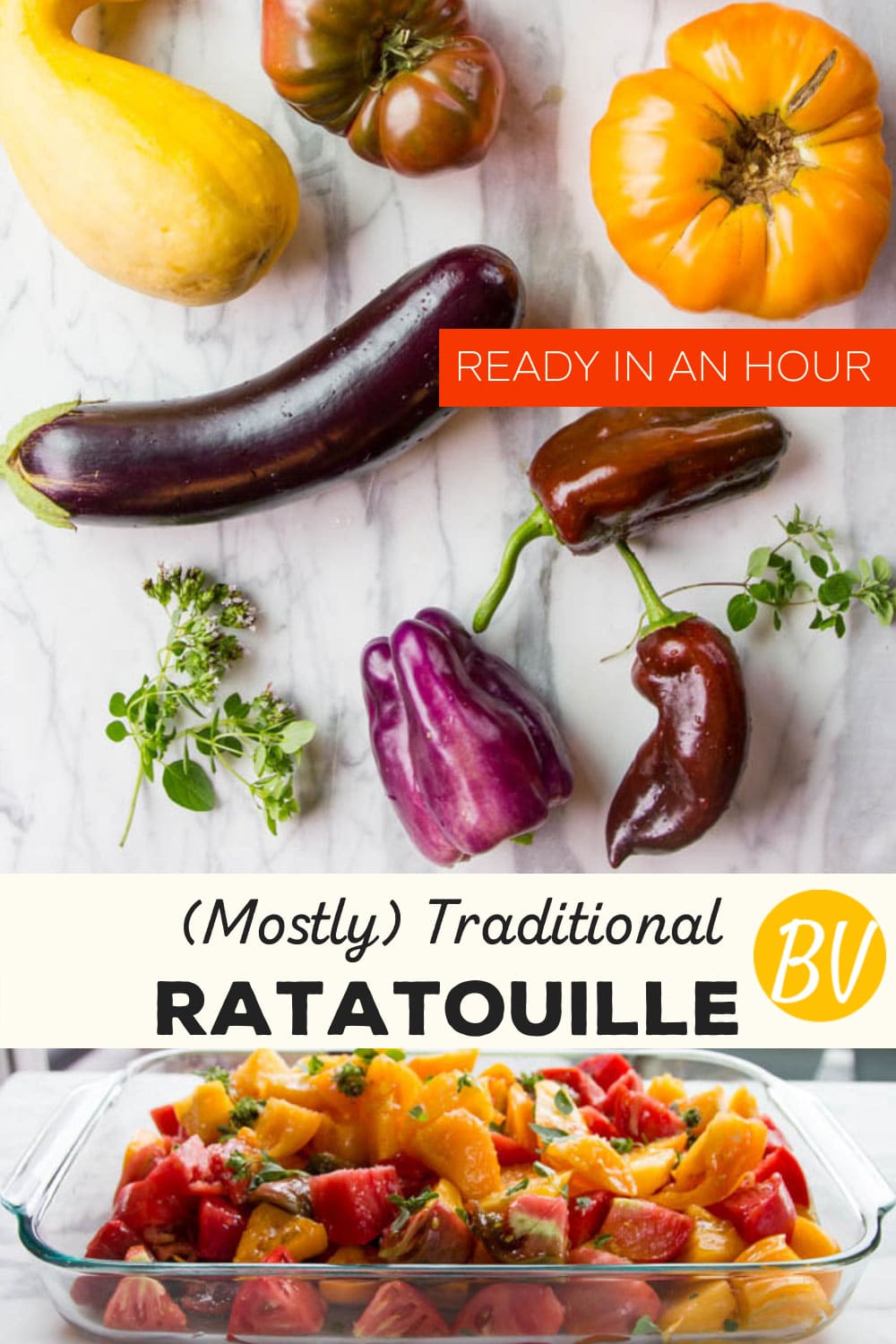




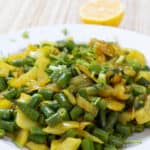









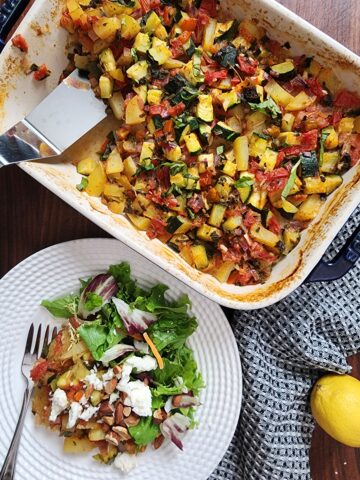
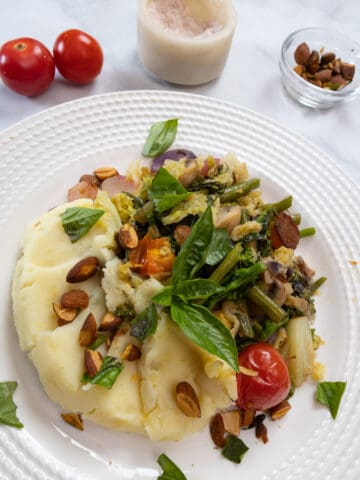

Leave a Reply